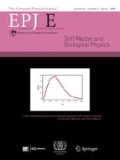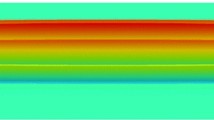Abstract
The wrinkle pattern exhibited upon stretching a rectangular sheet has attracted considerable interest in the “extreme mechanics” community. Nevertheless, key aspects of this notable phenomenon remain elusive. Specifically—what is the origin of the compressive stress underlying the instability of the planar state? what is the nature of the ensuing bifurcation? how does the shape evolve from a critical, near-threshold regime to a fully developed pattern of parallel wrinkles that permeate most of the sheet? In this paper we address some of these questions through numerical simulations and analytic study of the planar state in Hookean sheets. We show that transverse compression is a boundary effect, which originates from the relative extension of the clamped edges with respect to the transversely contracted, compression-free bulk of the sheet, and draw analogy between this edge-induced compression and Moffatt vortices in viscous, cavity-driven flow. Next, we address the instability of the planar state and show that it gives rise to a buckling pattern, localized near the clamped edges, which evolves—upon increasing the tensile load—to wrinkles that invade the uncompressed portion of the sheet. Crucially, we show that the key aspects of the process—from the formation of transversely compressed zones, to the consequent instability of the planar state and the emergence of a wrinkle pattern—can be understood within a Hookean framework, where the only origin of nonlinear response is geometric, rather than a non-Hookean stress–strain relation.
Graphic abstract








Similar content being viewed by others
Notes
“buckling” is thus understood as a particular instance of “wrinkling,” where the power \(\alpha =0\).
The error incurred by considering BCs through the undeformed, rather the deformed sheet, is a higher order in T/Y.
References
N. Friedl, F. Rammerstorfer, F. Fischer, Computers and Structures 78, 185 (2000)
E. Cerda, K. Ravi-Chandar, L. Mahadevan, Nature 419, 579 (2002)
V. Nayyar, K. Ravi-Chandar, R. Huang, International Journal of Solids and Structures 48, 3471 (2011)
S.T. Milner, J.F. Joanny, P. Pincus, Euro. Phys. Lett. 9, 495 (1989)
N. Bowden, S. Brittain, A.G. Evans, J.W. Hutchinson, G.M. Whiteside, Nature 393, 146 (1998)
E. Cerda, L. Mahadevan, Phys. Rev. Lett. 90, 074302 (2003)
H. Wagner, Z Flugtechn Motorluftschiffahrt 20, 8 (1929)
M. Stein, J.M. Hedgepeth, Technical report, NASA (1961)
E.H. Mansfield, The Bending and Stretching of Plates (Cambridge University Press, 1989)
A.C. Pipkin, IMA J. Appl. Math. 36, 85 (1986)
D.J. Steigmann, Proc. Roy. Soc. London A. 429, 141 (1990)
J.D. Paulsen, Annual Review of Condensed Matter Physics 10, 431 (2019)
D. Vella, Nat. Rev. Physics 1, 425 (2019)
K.A. Brakke, Exp. Math. 1, 141 (1992)
T.J. Healey, Q. Li, R.B. Cheng, J. Nonlin. Sci. 23, 777 (2013)
Q. Li, T.J. Healey, J. Mech. Phys. Solids 97, 260 (2016), symposium on Length Scale in Solid Mechanics - Mathematical and Physical Aspects, Inst Henri Poincare, Paris, FRANCE, JUN 19–20, 2014
A.A. Sipos, E. Feher, Int. J. Solids. Struct. 97–98, 275 (2016)
C. Fu, T. Wang, F. Xu, Y. Huo, M. Potier-Ferry, J. Mech. Phys. Solids 124, 446 (2019)
T. Wang, C. Fu, F. Xu, Y. Huo, M. Potier-Ferry, Int. J. Eng. Sci. 136, 1 (2019)
A. Panaitescu, M. Xin, B. Davidovitch, J. Chopin, A. Kudrolli, Phys. Rev. E 100, 053003 (2019)
L.D. Landau, E. Lifshitz, Theory of Elasticity (Pergamon, New York, 1986)
J.P. Benthem, The Quarterly Journal of Mechanics and Applied Mathematics 16, 413 (1963)
D.A. Spence, IMA. J. App. Math. 30, 107 (1983)
J. Chopin, A. Panaitescu, A. Kudrolli, Phys. Rev. E 98, 043003 (2018)
H.K. Moffatt, J. Fluid. Mech. 18, 1 (1964)
P.N. Shankar, M.D. Deshpande, Annual Review of Fluid Mechanics 32, 93 (2000)
Acknowledgements
We thank F. Brau, E. Cerda, J. Chopin, P. Damman, A. Kudroli, and N. Menon for valuable discussions. This research was funded by the National Science Foundation under Grant DMR 1822439. Simulations were performed in the computing cluster of Massachusetts Green High Performance Computing Center (MGHPCC).
Author information
Authors and Affiliations
Contributions
Both authors contributed equally to this paper.
Corresponding author
Solution of planar stress
Solution of planar stress
In this Appendix, we describe the detailed solution of model B with BCs (6e–6h). In our analysis we follow closely the calculation of Benthem [22], who employed Laplace transformation to compute the stress at the clamped edge. Here we go beyond Benthem solution by performing an inverse Laplace transformation, which is required to evaluate the stress in the whole sheet.
1.1 The singularities in the corners
Let us consider first the vicinity of one corner of the sheet in Fig. 1a, where one edge is clamped and the other one is free, and solve Eq. 4 in polar coordinates \((r, \theta )\), see Fig. 8, which depicts the left bottom corner.
The general solution of Eq. 16 is
Notice that Eq. (18) has 4 unknowns \(D_i\), such that the four BCs (17) give rise to a nonzero solution only if the determinant of the corresponding \(4 \times 4\) matrix vanishes, yielding:
For a sheet with positive Poisson’s ratio, \(\nu > 0\), the solution of Eq. (19) is \(\gamma < 1\), such that:
and hence the components of stress tensor diverge at the corner (i.e., \(r \rightarrow 0\)). For convenience, we choose to focus on a specific value, \(\gamma = 3/ 4\), which corresponds to \(\nu = \frac{17 + 4 \sqrt{2} - 8 \sqrt{7}}{4 \sqrt{2} - 1} \approx 0.32\). For this value, the boundary values of \({\sigma _{\theta \theta }}\) and \({\sigma _{r\theta }}\) are given by [22]:
1.2 Laplace transformation
Let us address now the Airy potential in a semi-infinite sheet (Fig. 9). For convenience, we set the width \(W = 2\) (i.e., \(y \rightarrow {\tfrac{y}{2W}}, x \rightarrow {\tfrac{x}{2W}}\)), and transform the origin of the coordinate system to the middle of left edge, such that the left clamped boundary is \(x=0\) and the two free boundaries are \(y = \pm 1\).
To solve Eq. (4), we employ Laplace transformation,
such that the transformed Eq. (4) becomes
With the up-down symmetry \(\varPhi (x,y) = \varPhi (x,-y)\), the singularities at corners, Eq. (21), and BC (6e), we can assume [22]
where \(q_n = (2n-1) \frac{\pi }{2}\), \(k_n = n \pi \) and \(a_n,\ b_n\) are constants that must be computed. Equation (24) and the BCs (6g, 6h) enable us to express all boundary terms in the right side of Eq. (23) in terms of the unknowns \(c_1,c_2\) and \(a_n,b_n\), whereas the BCs (6e, 6f) become:
The solution f(s, y) to Eq. (23) can now be expressed in the following form [22]:
where g(s, y) is the particular solution of the non-homogeneous ODE (23), while the left two terms correspond to solutions of the homogeneous equation (i.e., replacing the right side with 0), which enable satisfying the BCs (25). The function g(s, y) is relatively complicated, and in order to express it compactly we define an “auxiliary” function:
where \(\varGamma (x; y)\) is the incomplete gamma function. Then g(s, y) can be written as
where \(b_0\) is an integration constant:
1.3 Solution of Laplace transform and its inversion
Next we must solve all unknowns \(a_n, b_n, c_1, b_0\) that define the function g(s, y), Eq. (28), substitute it in Eq. (26) to obtain the Laplace transform f(s, y), and perform the inverse transform
to obtain the Airy potential \(\varPhi (x,y)\).
Recalling that our analysis here assumes a semi-infinite sheet, for which we expect the stress potential \(\varPhi (x,y)\) vanishes exponentially away from the clamped edge at \(x =0\), we note that the Laplace transform f(s, y) must not have any poles at the right half of complex plane \(\text {Re}\,(s) > 0\). Inspection of Eqs. (26, 28) reveals that the only poles originate from the contribution of the homogeneous solutions of Eq. (23), namely, complex numbers s which solve the nonlinear equation:
This equation has an infinite sequence of solutions in the right half plane, \(\{ s_i \ and \ {\bar{s}}_i; i\in {\mathbb {N}}, \text {Re}\, (s_i)> 0, \text {Im}\, (s_i) > 0\}\), which can be arranged in increasing order, \(|s_{i+1}| > |s_i|\). Requiring the residues of f(s, y) at \(s_i\) and \({\bar{s}}_i\) to vanish, yields an infinite sequences of algebraic equations
where we used Eqs. (26, 28) and defined
Equations (32, 28), together with the complementary set of conjugate equations for the residues \(\text {Res}\, f({\bar{s}}_i, y) = \overline{\text {Res}\, f(s_i, y)}\), determine the unknowns \(a_n, b_n, c_1, b_0\) in Eq.( 28), and thereby the Laplace transform f(s, y) through Eq. (26). In order to obtain a numerical solution of this system of equations, we truncate the sequence of unknowns, and keep only the 1000 leading unknowns (ordered by increasing magnitude of the corresponding poles \(|s_i|\)).
Furthermore, in order to carry out the integration in Eq. (30), we can close the contour in the left half complex plane \(\text {Re}\, (s) < 0\) and compute it through the sum of residues of f(s, y). Noticing that the poles of f(s, y) in the complex s plane are solutions of Eq. (31), one readily realizes that the poles in the left half of the complex plane are \(\{-s_i,- {\bar{s}}_i \}\), and consequently:
Finally, recovering our transformation \(y\rightarrow \tfrac{2y}{W},\ x\rightarrow \tfrac{2x}{W}\) and define \(p_i = 2 s_i\), we can get Eq. (9b)
Rights and permissions
About this article
Cite this article
Xin, M., Davidovitch, B. Stretching Hookean ribbons part I: relative edge extension underlies transverse compression and buckling instability. Eur. Phys. J. E 44, 92 (2021). https://doi.org/10.1140/epje/s10189-021-00092-z
Received:
Accepted:
Published:
DOI: https://doi.org/10.1140/epje/s10189-021-00092-z






